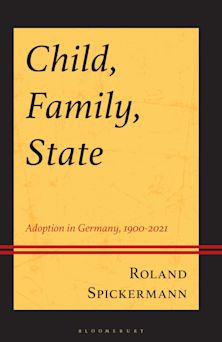- Home
- ACADEMIC
- History
- European History
- Nazi Germany
Nazi Germany
Society, Culture, and Politics
- Textbook
Nazi Germany
Society, Culture, and Politics
- Textbook
Inspection copy added to basket
Choose your preferred format. If you would prefer an ebook and it is not displayed below, please visit our inspection copies page.
Please note ebook inspection copies are fulfilled by VitalSource™.
Buy from Bloomsbury eTextBooks
You are now leaving the Bloomsbury Publishing website. Your eBook purchase will be with our partner https://www.vitalsource.com.
Your credit card statement will show this purchase originating from VitalSource Technologies. They will also provide any technical assistance you might require.
You must sign in to add this item to your wishlist. Please sign in or create an account
Description
Nazi Germany provides a comprehensive survey of the National Socialist dictatorship, artfully balancing social and cultural history with a political and military history of the regime.
The book unravels the complexities of the daily lives of perpetrators, victims, and bystanders in the 'Third Reich', and it also places events in Germany from 1933 to 1945 in a transnational context. Nazi Germany prompts readers to think about not only the historical debates but also the ethical questions that attend the study of this period. Pamela E. Swett and S. Jonathan Wiesen address:
*The movement's ideological origins and the party's rise to power
*The creation of a police state, the use of propaganda, and public support for Nazi ideas and programs
*The Nazis' persecution of religious, racial, and sexual minorities
*The place of youth, family, gender, and cultural expression in Nazi society
*The transnational influence of Nazism and preparations for war in Germany
*The Holocaust, resistance to Nazism, and the Second World War
Swett and Wiesen explore how the violence and racism of the Nazis coexisted alongside Germany's self-presentation as a 'normal' state with happy, productive citizens.Through exposure to the voices of contemporaries, readers will be prompted to consider key questions: How did German democracy give way to a brutal dictatorship so quickly? What was daily life like for 'average' Germans and those labeled as biological and political outsiders? Why did the Nazi dictatorship embark on a destructive war that led to the death of tens of millions of Europeans and to the demise of a political order that had become exceedingly popular by 1939?
Table of Contents
List of Maps and Charts
Introduction
1 The German Reich, Weimar, and the Birth of National Socialism
2 The National Socialist Rise to Power
3 Consolidating the Nazi Regime and Building a Police State
4 Racism and Biopolitics
5 Economy and Society
6 Arts and Culture
7 Youth, Gender, and Sexuality
8 Nazi Germany and the World
9 War and Empire, 1939–42
10 The Holocaust
11 Resistance and Rescue
12 Defeat, 1943–5
Select Bibliography
Index
Product details

| Published | 11 Jul 2024 |
|---|---|
| Format | Ebook (Epub & Mobi) |
| Edition | 1st |
| Extent | 352 |
| ISBN | 9781350112643 |
| Imprint | Bloomsbury Academic |
| Illustrations | 16 color illus and 58 bw illus |
| Publisher | Bloomsbury Publishing |
About the contributors
Reviews
-
Pamela Swett and Jonathan Wiesen have written what is likely to become the new standard single volume synthesis of Nazi Germany … The prose is smooth and authoritative, delivered in a singular voice and with a commendable economy of language.
Central European History
-
This is an outstanding account, brimming with insight, by two of the most distinguished scholars of Nazi Germany working in the English language today.
Neil Gregor, Professor of Modern European History, University of Southampton, UK
-
With Nazi Germany Pamela Swett and Jonathan Wiesen have done a great service to everyone who teaches courses on this difficult subject. Their book incorporates all of the latest findings in the rapidly developing research, and does things that no other textbook does – including its extensive exploration of sex and gender in the Third Reich, and its treatment of Nazi Germany and the world. What Swett and Wiesen write is always sensitive, nuanced, and balanced. They explain this complex history with admirable clarity in a way that is perfectly pitched for an undergraduate classroom. I think Nazi Germany is destined to become the standard textbook in its field.
Benjamin Hett, Professor of History, Hunter College and Graduate Center, USA



































